
 Bundesmarine, Type 120. Built 1957-64, in service until 1989:
Bundesmarine, Type 120. Built 1957-64, in service until 1989:Köln, Emden, Augsburg, Karlsruhe, Lübeck, Braunschweig
These were all built in Stülcken, Hamburg, as Type 120 Frigates, ordered in March 1957, designed in 1955-57 under program ‘Geleitboot 55’ (Escort 55). They were the worlds’ first warships to feature a combined diesel and gas propulsion system (CODAG). They were conventionally armed, but with an emphasis on ASW capabilities and later refits for increased hull protection and stability, new electronics, torpedo tubes removed and in the 1980s decoy launchers added. All discarded before the end of the Cold War in 1982-88, two were scrapped, the remainder four sold to Turkey, as the Gemlik class, retired in 1995.
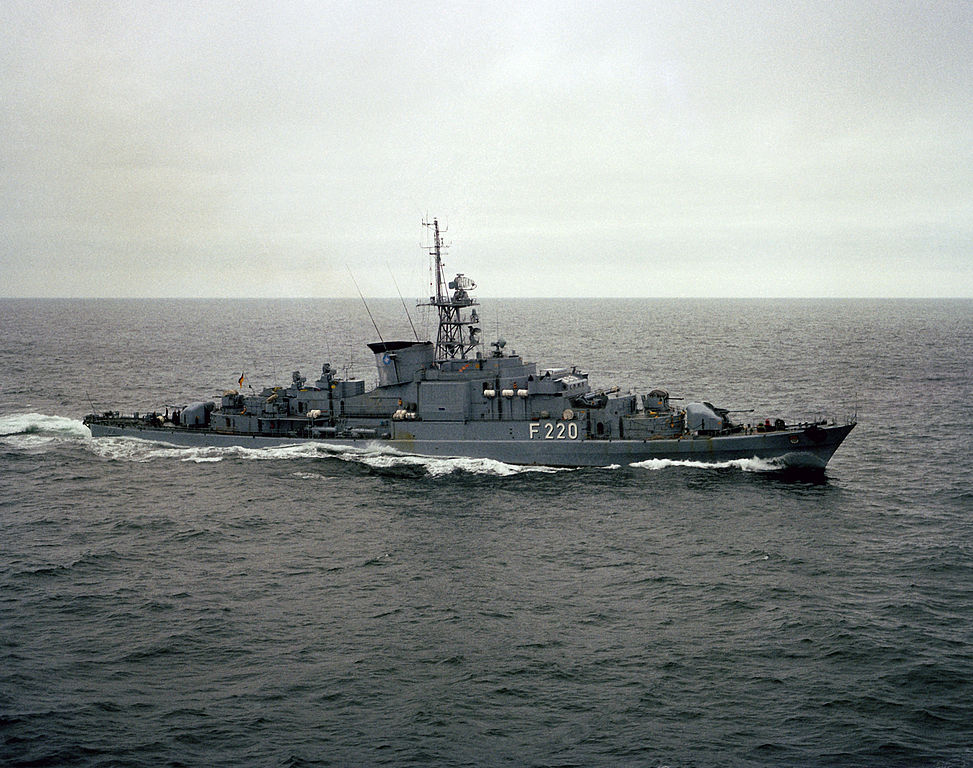
Development (1957-61)

There is not much info about how this class was developed, apart as a straightforward replacement for the ones in service with the Bundesmarine until then, the WW2 (modernized) Hunt class vessels of the Gneisenau and Scharnhost class frigates, all based on Hunt-class vessels, ex-RN. The latter were not only worn out in the late 1950s, but also lacked the speed necessary to hunt down the latest Project 614 and Project 611 or Project 658 Soviet submarines of the Baltic fleet.
Speed was thus an imperative, but also range, in the minds of the Bundesmarine naval staff when drafing in 1957 specifications for a new, local-built ASW frigate. Since the navy had many missions, these new ships would have also to escort convoys (hence a main gun and AA) and minelaying. At the time (1960), options for ASW warfare was revolving around WW2 solutions essentially, so hedgehog type weapons, such as the Bofors heavy rocket launcher, torpedo tubes and depth charges. Untile the introduction of ASROC and similar systems, this was the usual panoply.
The final draft was approved in early 1960, with a contract signed with a single yard for the whole delivery after competitive bids, won by H. C. Stülcken Sohn at Hamburg-Steinwerder.
Construction was almost identical to that of the Hamburg class, but a new CODAG drive that were promoted by the builder, at a unit cost of Each about 70 millions DM.
The ships were initially called “Geleitboot 55” in 1961 and assigned initially to the 2nd Escort Squadron in Cuxhaven.
The ships, in stark contrast to later German frigates more recently were over-armed, not under-armed, and this, combined with a relatively shallow-draft, massive structures, flush-deck, heavy armament, had in the end the same issues as the Hamburg class destroyers which design they followed. This obliged some modifications later in their career.
Design of the class
Hull and general design
The Class 120 frigates were built smooth-deckers with very elegant lines, very slanted bow, chine frames in the foredeck to provide good seaworthy characteristics.
The hull was divided into 13 watertight compartments, its only form of protection in case of a submarine hit (which were the hunted ones but could retialate).
The hull and parts of the superstructure were made of shipbuilding grade steel, very strong (notably structure framing), whereas other superstructures were made of aluminum. Due to the installation of gas turbines, large side air inlets were necessary, that could be closed by slats.
The whole ship was quite compact with a “single island” appearance, all located close to the forward center, between the single mast and funnel, no island aft but a sloping down structure. The main bridge was staggered, with an enclosed section and behind it an open deck. Behind the bridge superstructure, well developed over four levels above the weather deck, was installed the mainmast, a high lattice structure supporting the main radar and other antennas. The ships ended with a rounded poop after studies, not a squat one as usually seen at the time. The large, single funnel was sloped and had an apron to deflect smoke dirt from the aft structures.
Powerplant
A CODAG (Combined Diesel And Gas) drive was used for the first time in the Cologne class. This system consisted of four 16-cylinder V-diesel engines from MAN, each with 3,000 hp for cruising and two BBC gas turbines with 12,000 hp each for maximum speed, which could be connected via planetary gears and transmitted their power to two variable-pitch propellers.
Two electric plants, each with three MWM TRHs 5/18/V16 diesel generators with 550 hp (405 kW), were available to provide electricity. In normal operation, two to three generators were sufficient; To start up the two gas turbines, which were actually designed for onshore power plants, all six diesel generators had to be switched on. The main engines were in department five, the electrical plants in departments six and eight and the two gas turbines in department seven. Each turbine consumed 63 m³ air/sec and approximately 3.5 tons of diesel/h. Operating radius at 18 knots (kn): 5,200 nautical miles (nm), 23 kn: 3,500 nm and at full speed (30 kn): 950 nm.
Armament
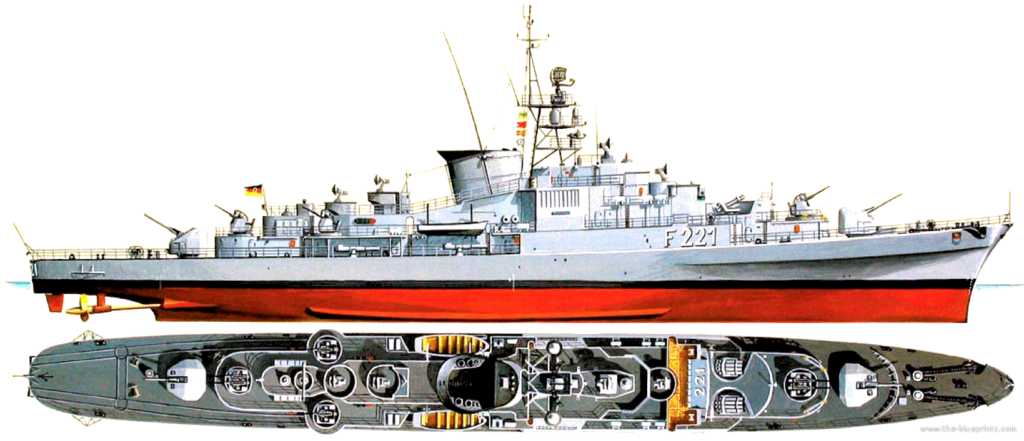
There was a 10 cm gun on the foredeck, and a 4 cm twin gun behind it, placed higher up. Behind them were two Bofors 37.5 cm quadruple anti-submarine rocket launchers. On the aft superstructure there was a single 4 cm Bofors gun on each side and another 4 cm double gun at the end of the superstructure. There was a second 10 cm gun on the quarterdeck. There were also two 53.3 cm torpedo tubes behind the front superstructure. They were used to fire Mk-44 torpedoes. Mine rails were laid behind the torpedo tubes and ran all the way to the stern.
Main
Sk 10,0 cm Canon de 100 mm modèle 53, same as in the French Navy. Forecastle, very wet in heavy weather, and stern deck, also close to the poop and low. It seems they were not upgraded to the M68 standard. Guided by dish-like guidance radars MV2/3Du, M4/1Du, M5/1Du, M9/3Du also shared by the AA mounts, four located in superfiring positions fore and aft.
⚙ specifications 100mm M53 |
|
| Weight | 22 tonnes (49,000 lb) |
| Caliber | 100 mm (3.9 in), 55 calibres 5,500 mm (220 in) |
| Elevation/traverse rates | 29°/s and 40°/s |
| Loading system | |
| Shell | 100x700mmR, 23.6 kg Ctg, 13.5 kg (30 lb) shell |
| Muzzle velocity | 870 m/s (2,900 ft/s) |
| Range | 17,000 m (40°) max, 6,000 m ceiling, 12,000 m surface effective |
| Guidance | Ship Radar |
| Crew | 10 in M53, 2 in M68 |
| Rate of Fire | 78 round/min |
AA: Breda and Bofors
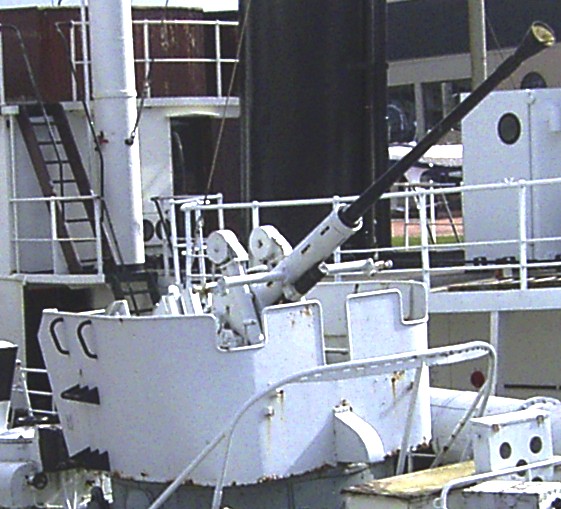
The Köln class had four AA weapons stations in all, two on the axis fore and aft in superfiring positions compared to the main guns, which were Breda twin mounts, and two Bofors single mounts of the /70 variant, both with automatic loading, located on wing’s platforms aft, close to the gunnery guidance radars.
Collectively the data showed 6× “Flak 4,0 cm”, assimilating the Bredas and Bofors. Either twn or single they were better shielded than WW2 mounts, as customary in the early cold war.
The first, made by OTO Melara were called the “Dardo” twin barreled 40 mm/L70 Breda Mod 58 II MDL anti-aircraft guns.
Rate of fire was 240–330 rpm and it was normally equipped with a twin belt connected to a 736-round magazine with dual feed mechanism.
The single mounts Bofors mounts weighted 2,400 kg (5,300 lb) for the gun itself, 4,800 kg (10,600 lb) for the whole mount, for c4 m long (13 ft 1 in), 2,800 mm (9 ft 2 in) for the barrel. It fired a 40 × 365 mm R 0.96 kg (2.1 lb) cartridge at 1,000 m/s (3,300 ft/s) and 240 rpm, at max 12,500 m (41,000 ft) with 26 round hoppers. This was also called the M1958 in NATO standards.
Bofors ASWR
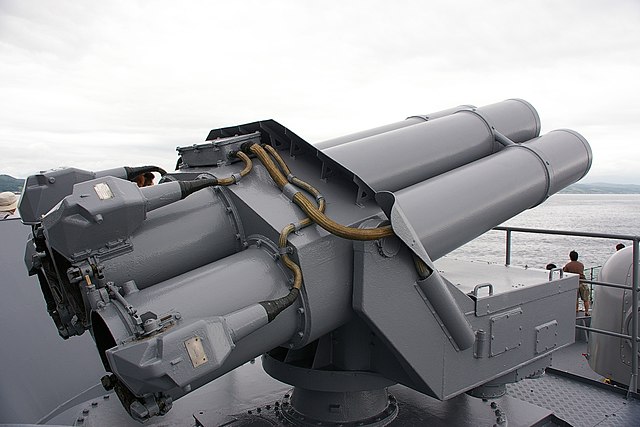
Another weapon system widely shared in NATO (apart Britain) was the four-barreled heavy anti-submarine rocker launcher called the U-Jagd-Raketenwerfer ⌀ 37,5 cm. Two mounted forward as customary since WW2 in elevated platforms in front of the bridge, behind the forward AA mount.
They fired 375 mm (14.8 in) Solid fuel Rockets at 3,625 m (11,893 ft) max, tipped with a Acoustic Proximity Fuse, High explosive torpex warhead.
Torpedo Tubes
Four Torpedorohr cal. 53,3 cm 21 inches, two twin banks amidship, weather deck, with limited traverse, but acoustic ASW “heavy” torpedoes that could be used an anti-ship role.
This was unlike the initial Hamburg class destroyers which had three fixed tubes at the bow and stern… They were removed at some point and replaced by smaller standard NATO 324 mm models on the weather deck. On the Koeln class, they were probably after refit 53.3 cm (21″) DM1 Seeschlange (Sea Serpent), which entered service in 1975, but before that, stock WW2 G7e T11 Zaunkönig 2 (1944) which were improved T5 less influenced by towed noise maker or similar devices. The G7E T11 was powered by Lead-acid batteries to 6,230 yards (5,700 m) at 24-25 knots, carrying a 440 lbs. (200 kg) Hexanite warhead.
Sensors
-KH14/9 navigation radar
-DA-02 target designation radar
-SGR103/SGR105 surface search radar
-MV2/3Du, M4/1Du, M5/1Du, M9/3Du fire control radars
-PAE1A + CWE10 sonar
Note, no details so far, the seach in ongoing.

⚙ Typ 120 Fregatte specifications |
|
| Displacement | 2090t/2750t standard/FL |
| Dimensions | 109.8oa x 11 x 4.60 m (360 ft 3 in x 36 ft 1 in x 15 ft 1 in) |
| Propulsion | 2 shaft CODAG, 2x Gas turbines, 4x Diesels 24,000+12,000hp |
| Speed | 32 knots (59 km/h; 37 mph) |
| Range | 360 t oil, 3,450 nm (6,390 km; 3,970 mi)/12 knots, 900 nm/30 kts |
| Armament | 2× 100mm METL 53, 2×2 40 mm/L70 Breda, 2×1 40 mm/L70 Bofors, 4× 533 mm TT, 2×4 375 mm ASWRL, DC, Mines |
| Sensors | Nav Radar KH14/9, Target des. radar DA-02, SFR SGR103, FCR M44, M45 Sonar PAE/CWE |
| Crew | 238 |
Career of the Köln class
On April 3, 1968, the 2nd Escort Squadron was moved from Cuxhaven to Wilhelmshaven. Emden and Karlsruhe left the squadron, temporarily joined the fleet service squadron in Flensburg, from which the Karlsruhe returned to the 2nd Escort Squadron on October 1, 1973 and Emden on April 1, 1974. All six Cologne-class (F120) units were part of the 2nd Escort Squadron in Cuxhaven and Wilhelmshaven so with interruptions. They had a typical cold war career, filled with ASW exercizes and weapons drills, but a few Soviet subs hunts, far in between.
 F220 Köln
F220 Köln

Köln in 2014
Köln was built on December 21, 1957 at the shipyard of H.C. Stülcken Sohn was laid down in Hamburg-Steinwerder and launched on December 6, 1958. On April 15, 1961, the ship was put into service by the German Navy. She was assigned to the 2nd Escort Squadron, later to the 2nd Frigate Squadron in Wilhelmshaven. Nothing of notice to signal.
After 21 years of service, she was decommissioned in Wilhelmshaven on December 17, 1982 and was initially used for spare parts but from November 1989 she became a training hulk “ex-Köln” at the Marine Damage Prevention Training Center (EAZS) in Neustadt. Crews seagoing units are trained here in firefighting, flooding or damage repair and prevention.
 F221 Emden
F221 Emden
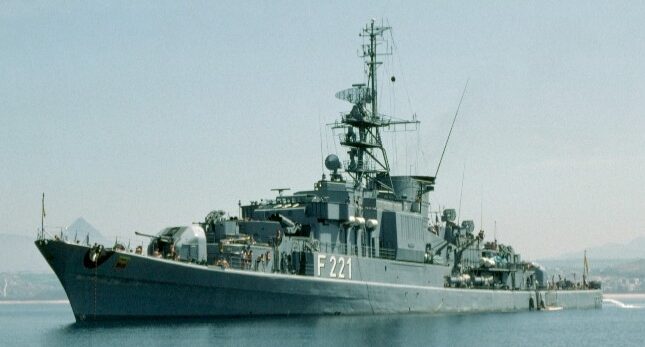
Emden’s keel was laid on April 15, 1958, she was launched on March 21, 1959, and after the usual sea trials, initial training, weapons and sensors qualifications, plus shakedown cruise, she was accecpted and commissioned by the Federal Navy on October 24, 1961. A training cruise occupied her half of 1962, followed by a deployment with the fleet in August, to the Azores, Bermuda and Canary Islands and then through Gibraltar to Toulon and back to Cuxhaven in October.
She started her second cruise from Cuxhaven in July 1963, Bay of Biscay, Gibraltar, but down the coast to Dakar in Senegal and westward to Las Palmas in Canary Islands, and back home in August.
The supper of 1964 she trained in the North Atlantic, by September she took part in the independence celebrations of Malta. March 31, 1965 saw her in maintenance overhaul until October 27, 1967 and from April 1968 she was versed into the 2nd Escort Squadron, Flensburg.
April 18, 1970, saw her departing for a South American trip, to Rio de Janeiro, Buenos Aires, Puerto Belgrano and back to Wilhelmshaven via Tenerife. In the summer she trained in Norwegian waters and from mid-May to fall June 1972 she took part in FOST (Flag Officer Sea Training) in Portland, Uk.
On January 6, 1973 she collided with the trawler Berlin and had repairs ay to Rönne in Bornholm, Denmark before heading to Kiel for final repairs.
March 1973 saw her at STANAVFORLANT from Flensburg via Portland and Madeira, Bermuda Islands and to Norfolk in Virginia, then Rhode Island, Baltimore and nortwards via Bermuda Islands to Halifax, Quebec, Charlottetown, Newport (USA), Ponta Delgada and back to Flensburg after 95 days, 17,903 nautical miles.
On April 1, 1974, Emden returned to the 2nd escort squadron, HP Wilhelmshaven.
In September 1975 she was back in Portland UK for Operational Sea Training and ÜAG 115/75 from mid-October to early November in Norwegia waters and at Den Helder, Netherlands. From mid-July to mid-August 1977, she was back in the Mediterranean with three sisters, with another FOST (Flag Officer Sea Training) in Portland back from mid-Sept. to mid-October. January 1978 saw her with STANAVFORLANT and she stopped ay Ponta Delgada, Hamilton in Bermuda, Charleston, Jacksonville, Mayport, Roosevelt Roads in Puerto Rico and Fort Lauderdale, Norfolk, Halifax, and while back, Lisbon and Nantes, then Wilhelmshaven in late May.
By mid-January 1980 she was again in Portland for BOST (Basic Operational Sea Training) and by April 1980, STANVFORLANT, stopping at Brest, Lisbon, Naples, Den Helder, Bodø in Norway, Zeebrugge for the fleet parade of the 150 years of Belgian independence, Narvik, Trondheim, Aarhus in Denmark and back in Wilhelmshaven fall August.
She later visited Newcastle upon Tyne by February 1982, Portland for BOST and “Northern Wedding” exercises from Dundee in Scotland in August 1982. Mid-March 1983, saw her in one of her last long cruises, to Cádiz, Port Said, Split and back in April 1983 (8,745 nautical miles).
She also regularly trained in the North Sea and Baltic, with exercises in the Skagerrak and Kattegat, as well as crossing the Arctic Circle.
On June 30, 1983, she was decommissioned, stricken September 23, 1983, sold, handed over to the Turkish Navy. The latter had her in service as the TCG Gemlik (D-361), on of the four transferred, only two operational. She was indeed destroyed by a fire on board, decommissioned in Aliağa by January 1994, stricken and BU.
 F222 Augsburg
F222 Augsburg
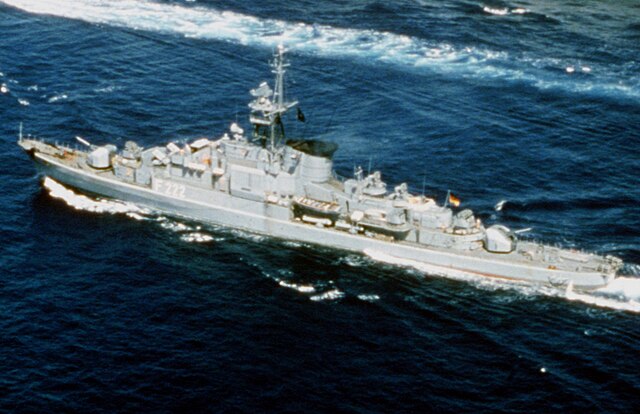
During her service, Augsburg took part in maneuvers and exercises in the North and Baltic Seas, Atlantic, Mediterranean. She took part in celebrations for the 75th anniversary of Heligoland seizure by the German Empire on August 10, 1965, fleet parade in Portsmouth (20th anniversary) with Braunschweig and Bayern in front of Queen Elisabeth and the Duke of Edinburgh; May 16, 1969. She was visited by King Olaf V of Norway on June 8, 1973 and became fleet flagship at the farewell cruise at Kiel.
On January 12, 1967, she was in modernization overhaul until January 7, 1969.
In the night of May 9, 1975, she collided with the Polish ‘Profesor Bohdanowicz’ in the Skagerrak and damage was sever, four injured. She was repaired in Emergency at Grimstad, Norway and in Germany from October 1, 1975 to October 11 1976. On January 18, 1982 she had another collision, with the British fleet supplier HMS Tidespring in maneuver. October 1, 1985 while in berthed in Wilhelmshaven she was rammed by a Soviet tug, with 630,000 DM in damage.
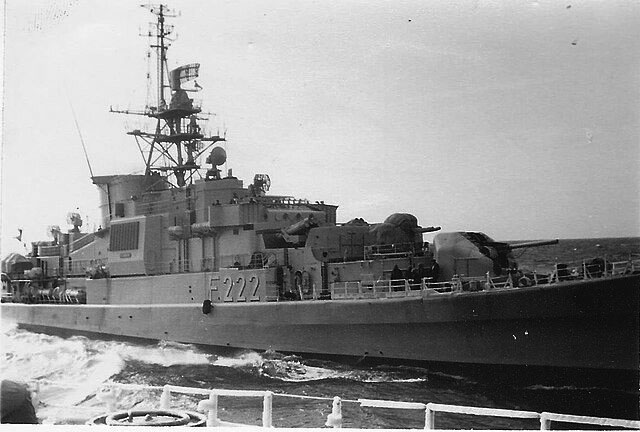
Ausgsburg in the north sea, March 1971
After a NATO maneuver, she was in maintenance overhaul at Lloyd Werft Bremerhaven by September 1986. She was strenghtened, notably for the superstructures, had new electronics for a total cost of 30 million DM. After this, she was to cruise in West Africa for three months and Atlantic but instead was assigned DESEX 1/87 exercise. Her last mission comprised an official visit to Den Helder in 1987. By October 1st she was decommissioned, stricken August 30th, 1988. Berthed at Wilhelmshaven she was put for sale, sold to Vebeg GmBh, towed to Hamburg on on November 1989, scrapped.
 F223 Karlsruhe
F223 Karlsruhe

Karlsruhe was laid down on 15 December 1958, launched on 24 October 1959 and commissioned by 15 December 1962 with her shakedown cruise by June 1962 and acceptance trip in November under Lieutenant Commander Helmut Eggers, until March 1964. By December 15, 1962 she was versed to the 2nd escort squadron in Cuxhaven. On March 21, 1968, she was reassigned to the fleet service squadron at Flensburg. On September 25, 1973, she was reassigned to the 2nd Escort Squadron, now HP Wilhelmshaven. In total in her career she cruised 300,000 nautical miles (14 times the circumference of the earth). After a service resembling her sisters but without notable incident, she was sold to Turkey, sailing there by March 28, 1983 as TGC Gazi Osman Pasa Pasha, D 360. In 1984 she was renamed TGC Gelibolu, and was decommissioned June 27, 1994.
 F224 Lübeck
F224 Lübeck
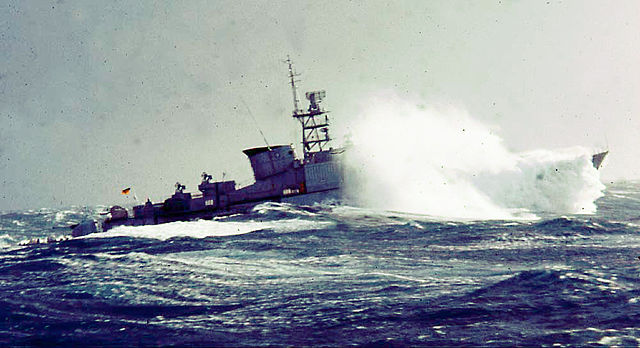
lübeck was laid down on October 28 1959, launched July 23 1960 and completed on June 6 1963. No service records published (yet). After 25 years of service, she was decommissioned on 30 September 1988 and sold to Turkey, sailing on 14 November, for Gölcük, Kocaeli, with a 140 skeleton crew, formally decommissioned on 1 December 1988, handed over to be cannibalized and maintain the two others in service until probably the late 1990s.
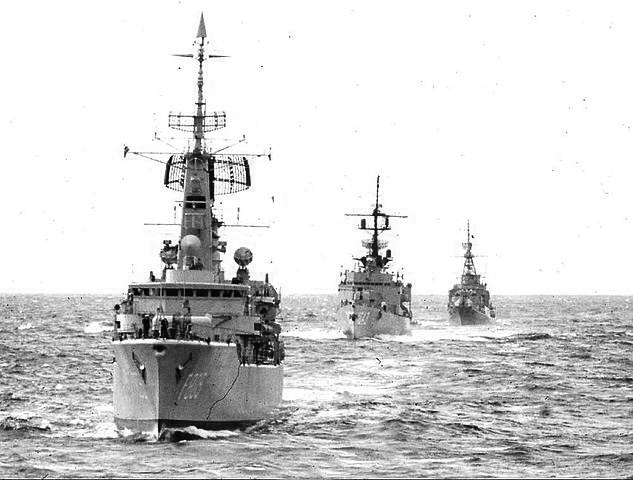
Lübeck on the background, after USS Mc Donnnel and Van Nes off Lisbon February 1975
 F225 Braunschweig
F225 Braunschweig
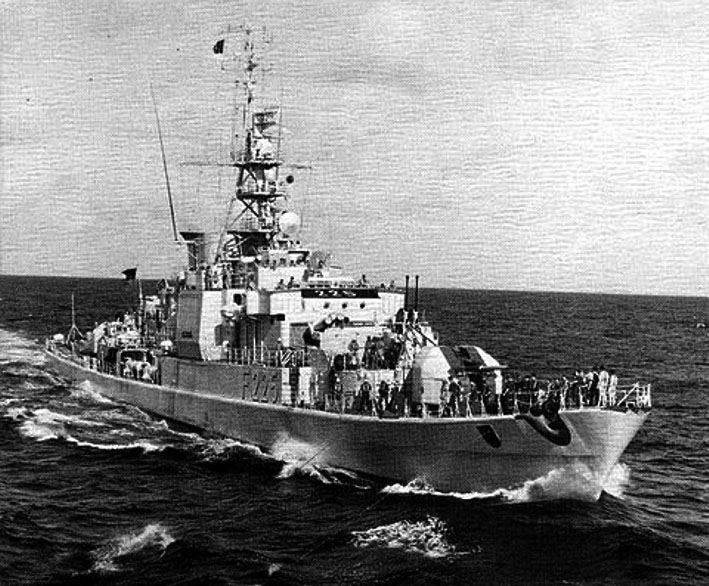
Braunschweig was laid down on 28 July 1960, launched on 3 February 1962, commissioned on 16 June 1964.
She belonged to the 2nd escort squadron, Cuxhaven and from 1968, Wilhelmshaven. She was decommissioned in 1989, handed over to the Turkish Navy for spare parts, maintaining her two sister ships ex Emden and ex Karlsruhe. After Gemlik (ex Emden) wa devatasted by a fire the former Braunschweig was replaced in unscheduled service in 1992 under the same name and went on for a few years.
Read More/Src
Books
Siegfried Breyer, Gerhard Koop: Die Schiffe, Fahrzeuge und Flugzeuge der deutschen Marine 1956 bis heute. München 1996
Conway’s all the world’s fighting ships 1947-95
Hugh und David Lyon: Kriegsschiffe von 1900 bis heute Technik und Einsatz. Buch und Zeit Verlagsgesellschaft mbH, Köln 1978
Links
secretprojects.co.uk/ bundesmarine-naval-projects
globalsecurity.org/ type-120
de.wikipedia.org/wiki/F120
commons.wikimedia.org/ Category Typ 120 FF
frk-koeln.de/
f223.de/
fregatte-koeln.de index
fregatteemden.de/s fregatte-emden
bgef.de/
seaforces.org/
fregatte-koeln.de/
bundeswehr.de/
Videos
Learning movie (EN subtitles) of the Bundesmarine, Koeln class, in the 1960s, classix archives
Model Kits
https://www.scalemates.com/topics/topic.php?id=72892
German Bundesmarine Bremen Class Frigate – Koln and diecast

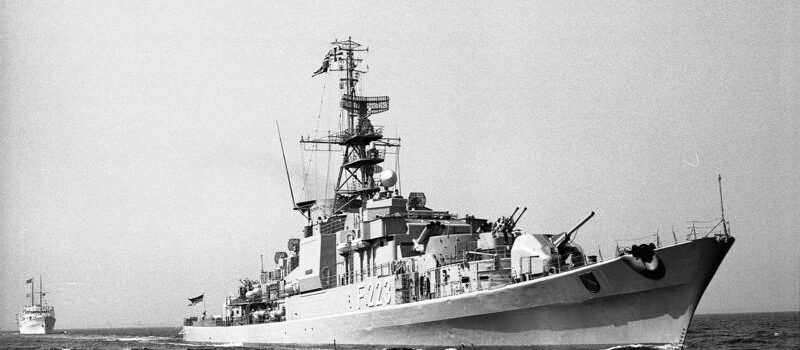
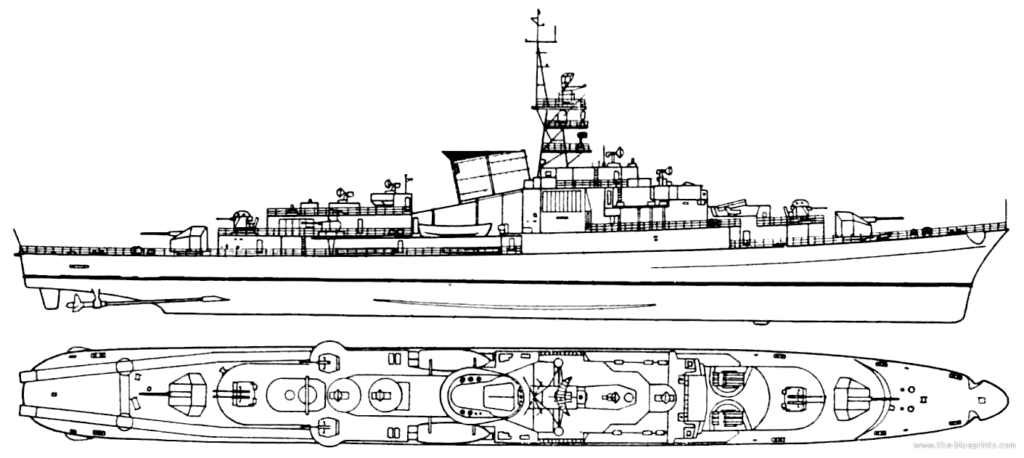
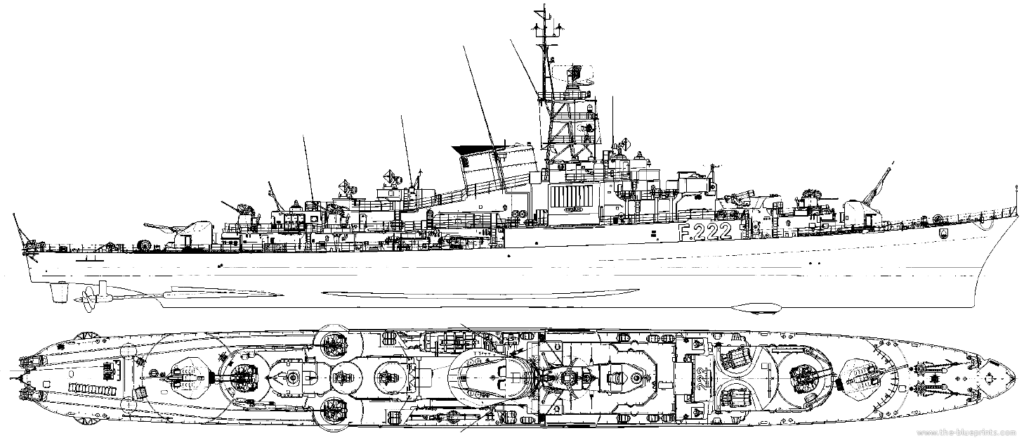
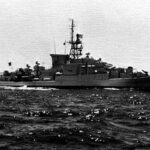
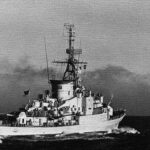
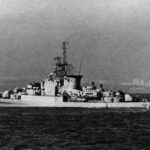
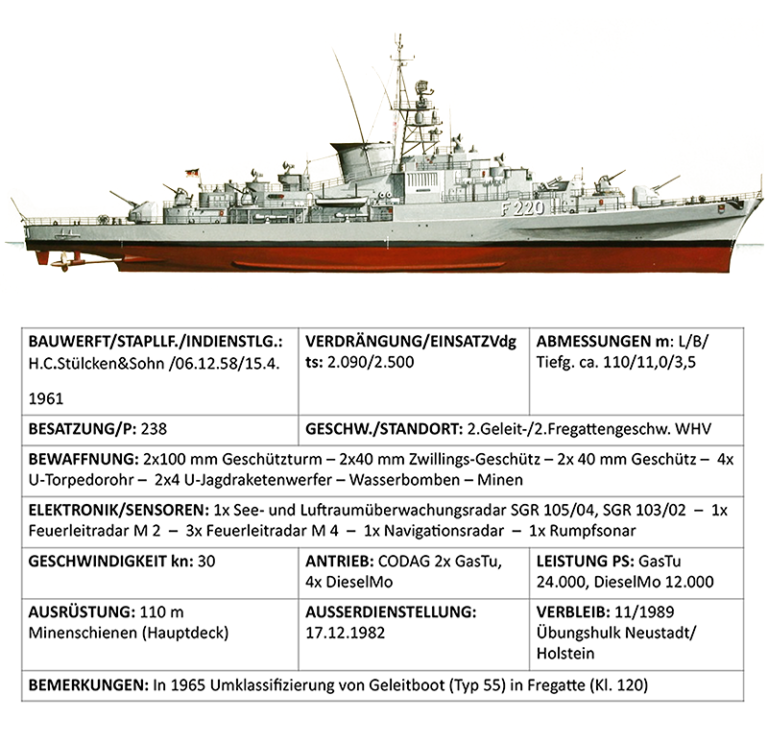
 Latest Facebook Entry -
Latest Facebook Entry -  X(Tweeter) Naval Encyclopedia's deck archive
X(Tweeter) Naval Encyclopedia's deck archive Instagram (@navalencyc)
Instagram (@navalencyc)





 French Navy
French Navy Royal Navy
Royal Navy Russian Navy
Russian Navy Armada Espanola
Armada Espanola Austrian Navy
Austrian Navy K.u.K. Kriegsmarine
K.u.K. Kriegsmarine Dansk Marine
Dansk Marine Nautiko Hellenon
Nautiko Hellenon Koninklije Marine 1870
Koninklije Marine 1870 Marinha do Brasil
Marinha do Brasil Osmanlı Donanması
Osmanlı Donanması Marina Do Peru
Marina Do Peru Marinha do Portugal
Marinha do Portugal Regia Marina 1870
Regia Marina 1870 Nihhon Kaigun 1870
Nihhon Kaigun 1870 Preußische Marine 1870
Preußische Marine 1870 Russkiy Flot 1870
Russkiy Flot 1870 Svenska marinen
Svenska marinen Søværnet
Søværnet Union Navy
Union Navy Confederate Navy
Confederate Navy Armada de Argentina
Armada de Argentina Imperial Chinese Navy
Imperial Chinese Navy Marinha do Portugal
Marinha do Portugal Mexico
Mexico Kaiserliche Marine
Kaiserliche Marine 1898 US Navy
1898 US Navy Sovietskiy Flot
Sovietskiy Flot Royal Canadian Navy
Royal Canadian Navy Royal Australian Navy
Royal Australian Navy RNZN Fleet
RNZN Fleet Chinese Navy 1937
Chinese Navy 1937 Kriegsmarine
Kriegsmarine Chilean Navy
Chilean Navy Danish Navy
Danish Navy Finnish Navy
Finnish Navy Hellenic Navy
Hellenic Navy Polish Navy
Polish Navy Romanian Navy
Romanian Navy Turkish Navy
Turkish Navy Royal Yugoslav Navy
Royal Yugoslav Navy Royal Thai Navy
Royal Thai Navy Minor Navies
Minor Navies Albania
Albania Austria
Austria Belgium
Belgium Columbia
Columbia Costa Rica
Costa Rica Cuba
Cuba Czechoslovakia
Czechoslovakia Dominican Republic
Dominican Republic Haiti
Haiti Hungary
Hungary Honduras
Honduras Estonia
Estonia Iceland
Iceland Eire
Eire Equador
Equador Iran
Iran Iraq
Iraq Latvia
Latvia Liberia
Liberia Lithuania
Lithuania Mandchukuo
Mandchukuo Morocco
Morocco Nicaragua
Nicaragua Persia
Persia San Salvador
San Salvador Sarawak
Sarawak Uruguay
Uruguay Venezuela
Venezuela Zanzibar
Zanzibar Warsaw Pact Navies
Warsaw Pact Navies Bulgaria
Bulgaria Hungary
Hungary

 Bundesmarine
Bundesmarine Dutch Navy
Dutch Navy Hellenic Navy
Hellenic Navy Marina Militare
Marina Militare Yugoslav Navy
Yugoslav Navy Chinese Navy
Chinese Navy Indian Navy
Indian Navy Indonesian Navy
Indonesian Navy JMSDF
JMSDF North Korean Navy
North Korean Navy Pakistani Navy
Pakistani Navy Philippines Navy
Philippines Navy ROKN
ROKN Rep. of Singapore Navy
Rep. of Singapore Navy Taiwanese Navy
Taiwanese Navy IDF Navy
IDF Navy Saudi Navy
Saudi Navy Royal New Zealand Navy
Royal New Zealand Navy Egyptian Navy
Egyptian Navy South African Navy
South African Navy






























 Ukrainian Navy
Ukrainian Navy dbodesign
dbodesign